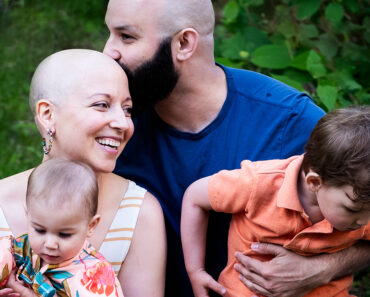I was heartbroken when I found out that I’d had a missed miscarriage in 2017. Two weeks after hearing our baby’s heartbeat for the first time, I went in for the first-trimester screening and the ultrasound team told me they could no longer hear it. A few hours later, my midwife explained that this meant our baby had died.
I researched online and learned more about our options for next steps: Wait for a natural miscarriage, ask a doctor for a pill to induce one, or undergo a dilation and curettage (D&C) procedure, during which a doctor dilates the cervix and clears out any remaining tissue from the uterus.
I preferred to go the natural route, but when our midwives arranged for me and my husband to meet with an OB/GYN a week later, she recommended a D&C, which filled me with fear and discomfort on top of the pain of losing our baby. The doctor explained that a D&C was safer because my body hadn’t initiated the miscarriage process yet and, at 12 weeks along, there were more risks (such as increased blood loss) with choosing a natural miscarriage.
The OB said she could perform the operation herself that very same day, so I had to decide quickly. While walking along the hospital halls, I weighed the risks and made the difficult decision to go ahead with the D&C. In the end, the hospital staff were extremely supportive every step of the way and it wasn’t as scary as I’d thought.
If you’ve been diagnosed with a missed or incomplete miscarriage, here’s what you need to know to decide whether a D&C is right for you and help you feel more prepared for the procedure.
What is a missed miscarriage and an incomplete miscarriage?
When a baby’s heart stops beating during pregnancy, this usually results in a natural miscarriage or a missed miscarriage. “Typically, as the pregnancy hormone hCG drops, the placental tissues detach from the uterine wall,” explains Constance Nasello, president of the Ontario Society of Obstetricians and Gynaecology (OSOG). “Other hormones cause the cervix to soften and open, and the uterus to contract, expelling the fetus and placental tissue.” If this process doesn’t happen immediately, it’s referred to as a missed miscarriage, and if it initiates but doesn’t naturally remove all the tissue from the pregnancy, it’s an incomplete miscarriage.
With a missed miscarriage, sometimes the body continues to “act pregnant.” Because the person still feels pregnant and has no signs of a miscarriage, like cramping and bleeding, it may take an ultrasound to discover that the baby has stopped growing.
For different reasons, a D&C procedure is sometimes recommended after a missed or incomplete miscarriage diagnosis to help initiate or complete the miscarriage.
What is a D&C procedure?
D&C stands for “dilation and curettage.” Dilation refers to the opening of the cervix, which is done using medication such as misoprostol (a pill that is taken orally or inserted in the vagina) or a small instrument. Curettage is the removal of abnormal tissue from the uterus using suction or a scraping tool called a curette.
“It’s a very common surgical procedure,” says Nasello, adding, “It’s done not only for women who are having miscarriages but also used as a diagnostic tool for women who are having issues with periods, bleeding, and sometimes for women undergoing infertility procedures to make sure the endometrium is changing appropriately throughout the menstrual cycle.”
D&C surgery is usually performed by an OB/GYN while the patient is under an anesthetic. “It may be a light general anesthetic,” says Nasello, “or sometimes ‘conscious sedation,’ where medication is given intravenously to keep the patient pain-free but also allow for quick awakening after surgery.”
How long is the D&C? Is it painful?
A D&C usually lasts about 10 minutes. Since the pregnant person is under an anesthetic, they don’t feel any pain.
Once the surgery is complete, the anesthesiologist stops the anesthesia and patients usually wake up soon after. They are then taken to a post-anesthetic care unit, where they’re observed for about half an hour to ensure that they’re recovering well before heading home.
How long does it take to recover from a D&C procedure and what is the recovery like?
“Most people will leave the recovery room feeling pretty normal,” says Nasello, adding that typically patients experience light bleeding for seven days and sometimes spotting for up to 14 days. Some mild cramping is also normal. Most patients have a follow-up scheduled with their OB, family doctor or nurse practitioner to ensure that they’re recovering well.
If a person is still experiencing prolonged heavy bleeding after 10 to 14 days, this could be a sign of a low-grade infection called endometritis, which is inflammation of the lining of the uterus. “This typically causes the blood to be darker, mucousy and difficult to wipe away,” warns Nasello, adding that other common symptoms include fever and cramping, and sometimes changes in bowel functions. If you have any concerns, contact your OB/GYN, midwife, family physician, or nurse practitioner.
There is another very important aspect of recovery that sometimes gets overlooked: the emotional side. “A miscarriage is a major life event,” says Nasello. “Not everybody understands what you’re going through.” Someone who has experienced a miscarriage may feel a wide range of emotions, including shock and sadness. Like other forms of grief, those emotions can come in waves, triggered by memories, the sight of maternity clothes or things bought for the baby, comments from others or someone else’s good pregnancy news.
Not feeling emotionally stable after a miscarriage is totally normal, but if you’re experiencing persistent grief and sadness long after the procedure, you should speak to your family doctor or health care provider. Nasello adds that some people feel very isolated and can develop a brief mood disorder or postpartum depression. When calling to book your appointment, Nasello advises informing your health care provider that you want to talk about how you’re feeling so they can adjust their schedule to ensure that they’re able to spend more time with you and provide next steps.
Are there any complications, risks or side effects that can arise from a D&C after a miscarriage?
Bleeding is a possible side effect of a D&C procedure, and less than one percent of the time people experience complications from hemorrhaging. In these rare instances, doctors will stop the bleeding with medicine or more invasive techniques that put pressure on the bleed.
If a person experiences hemorrhaging before, during or after their D&C, Nasello says it will take about two weeks for their body to make new hemoglobin and at least a month before they regain their energy. “It’s also important if the blood count has dropped to take some iron to help build up your iron stores.”
There is also a low risk of infection or inflammation. This is more common if someone is in the middle of a miscarriage when they have the D&C, at which point their cervix is open and organisms and bacteria can enter and cause inflammation, which can lead to an infection and cause endometritis.
Additionally, the cervix naturally softens during pregnancy and miscarriages, but if it’s closed it needs to be opened using instruments like a clamp or dilator, which can cause bleeding or uterine perforation. Doctors take precautions to prevent injury as much as possible, including using misoprostol to open the cervix before the D&C procedure takes place.
Nasello says that the chances of a cervical perforation happening are about two to four percent. The other kind of perforation that can occur in rare instances is uterine perforation, which tends to heal well and rarely has any complications.
Another complication is intrauterine scarring, which can result in infertility. “A D&C is a common procedure and this complication is quite rare,” says Nasello. “More than 99 percent of the time everything goes as anticipated.”
Is there anything a patient should avoid after D&C surgery?
Most people can resume regular activities the next day. “Sometimes going back to normal activities helps people with their emotional recovery and sometimes it doesn’t. It’s really an individual kind of thing,” says Nasello, adding that some people may prefer to take a couple of sick days before returning to work.
It’s also best to avoid intercourse for 10 to 14 days, to ensure the cervix is closed and to reduce the risk of inflammation and infection.
Can a D&C procedure affect your chances of getting pregnant again?
“Fertility returns as soon as the pregnancy hormone (hCG) is cleared from the bloodstream, and some people can be very surprised to find they got pregnant within two or three weeks of the D&C,” says Nasello. Some people worry about getting pregnant so quickly after the procedure, but she says this isn’t a concern.
More than anything, most doctors caution patients to ensure that they’re emotionally ready to start trying again, and to use adequate contraception if they’re not quite there yet.
When would a doctor recommend a patient have a D&C versus other missed miscarriage options?
Doctors consider a number of factors, including gestational age. If the missed miscarriage is diagnosed before 10 weeks gestation, there’s an option to take medication to prompt the miscarriage to take place. However, if there’s hemorrhaging or the uterus doesn’t empty completely, the patient will still need to undergo a D&C procedure. If the missed miscarriage is diagnosed after 10 weeks of pregnancy, a D&C is more likely to be recommended right away.
“Later in gestation, the medication may not be as effective and more women may need a surgical D&C for incomplete miscarriage or prolonged bleeding,” Nasello explains. “If a missed miscarriage is going to happen naturally, it’s usually before eight weeks of pregnancy.”
What happens if you have a missed miscarriage and choose not to have a D&C?
Some patients prefer to wait because they have hope their fetus is still developing, they’re not available right away due to obligations such as arranging for child care, or they prefer to have the miscarriage happen naturally. If the patient isn’t bleeding excessively, waiting can be safe.
“If there’s a problem with waiting, it’s usually bleeding, so they might require an emergency D&C. We try and give women all the information they need to make an informed choice,” says Nasello, adding that it’s worth keeping in mind that if the miscarriage doesn’t happen naturally within two weeks, it’s probably not going to happen easily.
“I always say to patients that there is nothing that you can do to cause, or prevent, a miscarriage.”

































